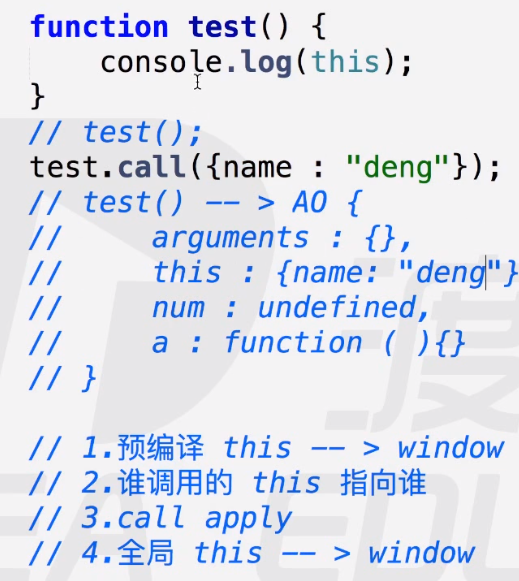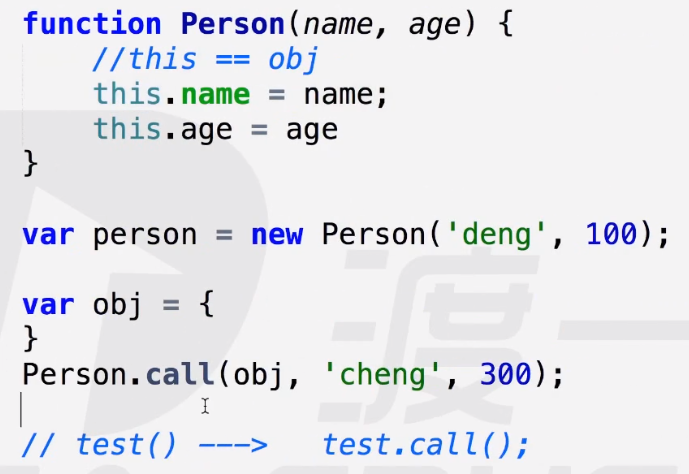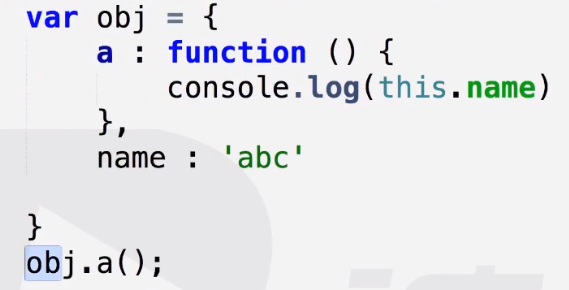


this都有一个共同点:它总是返回一个对象
this就是属性或方法“当前”所在的对象
this就是function.call()的第一个参数
function f() {return '姓名:'+ this.name;}var A = {name: '张三',describe: f};var B = {name: '李四',describe: f};A.describe() // "姓名:张三"B.describe() // "姓名:李四"//this始终指向当前var name = 'kangkang'var f = function() {return this.name;}console.log(f()) //kangkangvar name = 'kangkang'var f = function() {return name;}console.log(f()) //kangkang
实质
var f = function () {console.log(this.x);}var x = 1;var obj = {f: f,x: 2,};// 单独执行f() // undefined// obj 环境执行obj.f() // 2
函数预编译过程 this 指向 window,new 函数() this就指向对象
使用注意点
函数里this的指向
未被对象调用的函数里的this就指向全局,new以后就变成对象
var name = '222'var a = {name: '111',say: function() {console.log(this.name)},}var fun = a.say //函数的声明给了funfun() //222 fun里的this指向全局a.say() //111var b = {name: '333',say: function(fun) {fun() //没有谁在调用fun,所以fun里的this指向全局},}b.say(a.say) //222b.say = a.sayb.say() //333
var a = 5function test() {a = 0 //testAO里的aconsole.log(a) //0console.log(this.a) //this指向全局 5var a //定义提升 把a放到了testAO里console.log(a) //0}test()new test() //把this变成了{}
避免多层 this
由于this的指向是不确定的,所以切勿在函数中包含多层的this
//嵌套函数指向全局对象var a = 2var o = {a: 1,f1: function () {console.log(this.a);var f2 = function () {console.log(a);}();}}console.log(o.f1())//1//2var a = 2var o = {a: 1,f1: function () {console.log(this.a);var that = thisvar f2 = function () {console.log(that.a);}();}}console.log(o.f1())//1//1
避免数组处理方法中的 this
数组的map和foreach方法,允许提供一个函数作为参数。这个函数内部不应该使用this
var o = {v: 'hello',p: [ 'a1', 'a2' ],f: function f() {this.p.forEach(function (item) {console.log(this.v + ' ' + item);});}}o.f()// undefined a1// undefined a2//将this当作foreach方法的第二个参数,固定它的运行环境var o = {v: 'hello',p: [ 'a1', 'a2' ],f: function f() {this.p.forEach(function (item) {console.log(this.v + ' ' + item);}, this);}}o.f()// hello a1// hello a2
避免回调函数中的 this
var o = new Object();o.f = function () {console.log(this === o);}// jQuery 的写法$('#button').on('click', o.f);//点击按钮以后,控制台会显示false。原因是此时this不再指向o对象,而是指向按钮的 DOM 对象
绑定 this 的方法
JavaScript 提供了call、apply、bind这三个方法,来切换/固定this的指向
Function.prototype.call()
所有函数的调用,其实都是 func———>func.call()

借用其他函数,实现自己功能
function Wheel(style, wheelSize) {this.style = stylethis.wheelSize = wheelSize}function Sit(c, siteColor) {this.c = cthis.siteColor = siteColor}function Car(name, style, wheelSize, c, siteColor) {this.name = nameWheel.call(this, style, wheelSize)Sit.call(this, c, siteColor)}var car = new Car('BMW', '花里胡哨', 100, '真皮', '红色')console.log(car)//Car {name: 'BMW', style: '花里胡哨', wheelSize: 100, c: '真皮', siteColor: '红色'}
函数实例的call方法,可以指定函数内部this的指向(即函数执行时所在的作用域),然后在所指定的作用域中,调用该函数
var obj = {};var f = function () {return this;};console.log(f.call(obj) === obj) // true
call方法的参数,应该是一个对象。如果参数为空、null和undefined,则默认传入全局对象
call的第一个参数就是this所要指向的那个对象,后面的参数则是函数调用时所需的参数
function add(a, b) {return a + b;}add.call(this, 1, 2) // 3
call方法的一个应用是调用对象的原生方法
var obj = {};obj.hasOwnProperty('toString') // false// 覆盖掉继承的 hasOwnProperty 方法obj.hasOwnProperty = function () {return true;};obj.hasOwnProperty('toString') // trueObject.prototype.hasOwnProperty.call(obj, 'toString') // false
Function.prototype.apply()
apply方法的作用与call方法类似,也是改变this指向,然后再调用该函数。唯一的区别就是,它接收一个数组作为函数执行时的参数,该数组的所有成员依次作为参数,传入原函数。原函数的参数,在call方法中必须一个个添加,但是在apply方法中,必须以数组形式添加
function f(x, y){console.log(x + y);}f.call(null, 1, 1) // 2f.apply(null, [1, 1]) // 2
找出数组最大元素var a = [10, 2, 4, 15, 9]; Math.max.apply(null, a) // 15
将数组的空元素变为undefinedArray.apply(null, ['a', ,'b']) // [ 'a', undefined, 'b' ]
转换类似数组的对象
Array.prototype.slice.apply({0: 1, length: 1}) // [1]Array.prototype.slice.apply({0: 1}) // []Array.prototype.slice.apply({0: 1, length: 2}) // [1, undefined]Array.prototype.slice.apply({length: 1}) // [undefined]
绑定回调函数的对象
var o = new Object();o.f = function () {console.log(this === o);}var f = function (){o.f.apply(o);// 或者 o.f.call(o);};// jQuery 的写法$('#button').on('click', f);
Function.prototype.bind()
bind方法用于将函数体内的this绑定到某个对象,然后返回一个新函数
var counter = {count: 0,inc: function () {this.count++;}};var obj = {count: 100};var func = counter.inc.call(obj);func();console.log(obj.count)//bind还可以接受更多的参数,将这些参数绑定原函数的参数var add = function (x, y) {return x * this.m + y * this.n;}var obj = {m: 2,n: 2};var newAdd = add.bind(obj, 5);newAdd(5) // 20
每一次返回一个新函数
var listener = o.m.bind(o);element.addEventListener('click', listener);// ...element.removeEventListener('click', listener);
结合回调函数使用
var counter = {count: 0,inc: function () {'use strict';this.count++;}};function callIt(callback) {callback();}callIt(counter.inc.bind(counter));counter.count // 1
上面代码中,callIt方法会调用回调函数。这时如果直接把counter.inc传入,调用时counter.inc内部的this就会指向全局对象。使用bind方法将counter.inc绑定counter以后,就不会有这个问题,this总是指向counter
某些数组方法可以接受一个函数当作参数。这些函数内部的this指向,很可能也会出错
var obj = {name: '张三',times: [1, 2, 3],print: function () {this.times.forEach(function (n) {console.log(this.name);});}};obj.print()// 没有任何输出obj.print = function () {this.times.forEach(function (n) {console.log(this.name);}.bind(this));};
结合call方法使用
var push = Function.prototype.call.bind(Array.prototype.push);var pop = Function.prototype.call.bind(Array.prototype.pop);var a = [1 ,2 ,3];push(a, 4)a // [1, 2, 3, 4]pop(a)a // [1, 2, 3]
callee caller
arguments.callee 返回当前函数
var num = (function(n) {if (n == 1) {return 1}return n * arguments.callee(n - 1)})(100)console.log(num)
caller 返回调用的环境
function test() {demo()}test() //f testfunction demo() {console.log(demo.caller)}
链式调用





